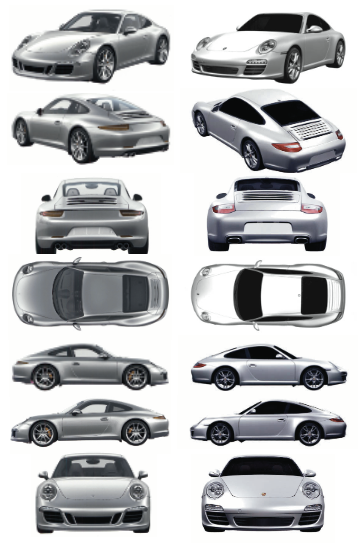Porsche loses design protection for its latest 911
This case concerned the successful cancellation by Autec AG, a producer of toy cars, of Porsche’s registered Community design for the latest iteration of the 911 (below, left) as a result of their earlier existing registered Community design (below right).

The case considered the extent the “informed user” would consider the differences between the two and how broad the body of prior art should be.
Porsche’s appeal before the General Court was against the decision to cancel their registered Community design for lack of individual character. Their main argument was that the two models “differ significantly” and “differ so clearly” in their outward appearance that the Board of Appeal could not have held, without making an error of assessment, that the contested design lacked individual character.
Case law confirms that the individual character of a registered Community design must be assessed first in light of the overall impression conveyed to the informed user concerned and; second, the overall impression must be different from that produced by another earlier design.
The informed user
The Board of Appeal had held, that the informed user of the products concerned by the conflicting designs was not just the user of the Porsche 911 passenger car, but of passenger cars in general. Moreover, informed users generally know that car manufacturers do not constantly develop new models but often simply modernise existing models.
Porsche argued however that their knowledge would be particularly high in the case of “expensive luxury limousines or sports cars”. The Board of Appeal had, rightly the General Court said, taken account of the broader category of products with the correct classification being ‘automobiles, buses and lorries’ in class 12-08. Porsche argued that the informed user would have had a greater than usual level of awareness as a result of the existence of the 911 car over a number of decades. Their argument, which may not have endeared themselves to the non-Porsche driving public, was that the 911 “naturally” receives “considerably more” attention than “normal” motor vehicles”, which have no special characteristics and are “more or less interchangeable”. Unimpressed, the General Court upheld the Board of Appeal’s rejection of this argument.
The designer’s freedom of design
The degree of freedom of the designer in developing the design in question should also be taken into account.
Porsche argued that the freedom of the designer is limited by market expectations, since consumers expect that the “design idea” or original form on which the Porsche 911 passenger car is based, perceived as “iconic”, will be retained in subsequent models. The General Court rightly confirmed that this was not the correct analysis and that the freedom of the designer must be not just in relation to the 911 but passenger cars in general.
Comparison of the overall impression produced by each of the conflicting designs
The General Court confirmed that two designs are regarded as identical if their characteristics differ only in insignificant details, that is to say, in details which do not give rise to any differences, not even minor ones, between those designs. Conversely, in order to assess the novelty of a design, it is necessary to examine whether there are differences, even small ones, between the old and new designs, which are not negligible. There was considerable debate regarding the headlamps which “curved outwards” and “conspicuously” differ from the headlamps of the earlier model, and that the door handles are “completely redesigned”. However, the General Court stated the side views, which represent the silhouette of each design as a whole, do not allow the opposing designs to be considered in such detail. They went on to say even if it is held that those differences may be observed by the informed user, they are not sufficiently pronounced to call into question the Board of Appeal’s assessment alone. According to the Board of Appeal, all the views of the designs in question, and not just the side views, show that they are identical in the shape and lines of their bodywork, both in terms of dimensions and proportions and in terms of the shape and arrangement of the windows and doors.
The General Court confirmed that the Board of Appeal had ruled correctly that the differences between the numerous views of the conflicting designs, taken individually and in combination, were too small to significantly affect the overall impression conveyed to the informed user.
Unsurprisingly Porsche’s appeal was dismissed.
What lessons can Porsche learn from this?
With more than 700 registered Community designs filed at the EUIPO in addition to their cars, as you would expect, they have also sought design protection for individual elements ranging from exhaust pipes and wing mirrors to rear spoilers and steering wheels. They have an extensive portfolio of design protection which should be sufficient to enable them to prevent third party use whether in relation to toys or after-market products. Seeking protection for a new iteration is always likely to be potentially open to challenge without clearly showing the new features and specifically highlighting them.